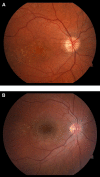Eculizumab for dense deposit disease and C3 glomerulonephritis
- PMID: 22403278
- PMCID: PMC3338285
- DOI: 10.2215/CJN.12901211
Eculizumab for dense deposit disease and C3 glomerulonephritis
Abstract
Background and objectives: The principle defect in dense deposit disease and C3 glomerulonephritis is hyperactivity of the alternative complement pathway. Eculizumab, a monoclonal antibody that binds to C5 to prevent formation of the membrane attack complex, may prove beneficial.
Design, setting, participants, & measurements: In this open-label, proof of concept efficacy and safety study, six subjects with dense deposit disease or C3 glomerulonephritis were treated with eculizumab every other week for 1 year. All had proteinuria >1 g/d and/or AKI at enrollment. Subjects underwent biopsy before enrollment and repeat biopsy at the 1-year mark.
Results: The subjects included three patients with dense deposit disease (including one patient with recurrent dense deposit disease in allograft) and three patients with C3 glomerulonephritis (including two patients with recurrent C3 glomerulonephritis in allograft). Genetic and complement function testing revealed a mutation in CFH and MCP in one subject each, C3 nephritic factor in three subjects, and elevated levels of serum membrane attack complex in three subjects. After 12 months, two subjects showed significantly reduced serum creatinine, one subject achieved marked reduction in proteinuria, and one subject had stable laboratory parameters but histopathologic improvements. Elevated serum membrane attack complex levels normalized on therapy and paralleled improvements in creatinine and proteinuria.
Conclusions: Clinical and histopathologic data suggest a response to eculizumab in some but not all subjects with dense deposit disease and C3 glomerulonephritis. Elevation of serum membrane attack complex before treatment may predict response. Additional research is needed to define the subgroup of dense deposit disease/C3 glomerulonephritis patients in whom eculizumab therapy can be considered.
Figures

Comment in
-
Monoclonal antibodies for the treatment of the C3 glomerulopathies.Clin J Am Soc Nephrol. 2012 May;7(5):704-6. doi: 10.2215/CJN.03010312. Epub 2012 Apr 12. Clin J Am Soc Nephrol. 2012. PMID: 22498497 No abstract available.
References
-
- Fakhouri F, Frémeaux-Bacchi V, Noël LH, Cook HT, Pickering MC: C3 glomerulopathy: a new classification. Nat Rev Nephrol 6: 494–499, 2010 - PubMed
-
- Servais A, Frémeaux-Bacchi V, Lequintrec M, Salomon R, Blouin J, Knebelmann B, Grünfeld JP, Lesavre P, Noël LH, Fakhouri F: Primary glomerulonephritis with isolated C3 deposits: A new entity which shares common genetic risk factors with haemolytic uraemic syndrome. J Med Genet 44: 193–199, 2007 - PMC - PubMed
-
- Appel GB, Cook HT, Hageman G, Jennette JC, Kashgarian M, Kirschfink M, Lambris JD, Lanning L, Lutz HU, Meri S, Rose NR, Salant DJ, Sethi S, Smith RJ, Smoyer W, Tully HF, Tully SP, Walker P, Welsh M, Würzner R, Zipfel PF: Membranoproliferative glomerulonephritis type II (dense deposit disease): An update. J Am Soc Nephrol 16: 1392–1403, 2005 - PubMed
Publication types
MeSH terms
Substances
Grants and funding
LinkOut - more resources
Full Text Sources
Other Literature Sources
Medical
Miscellaneous

